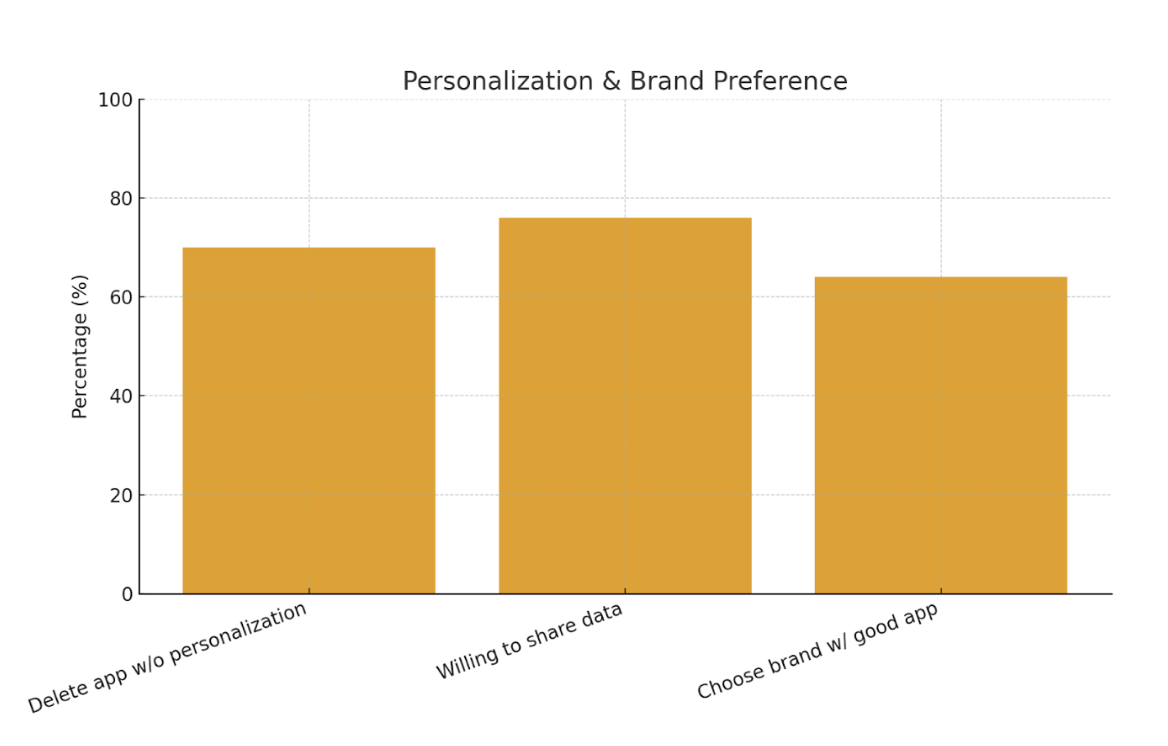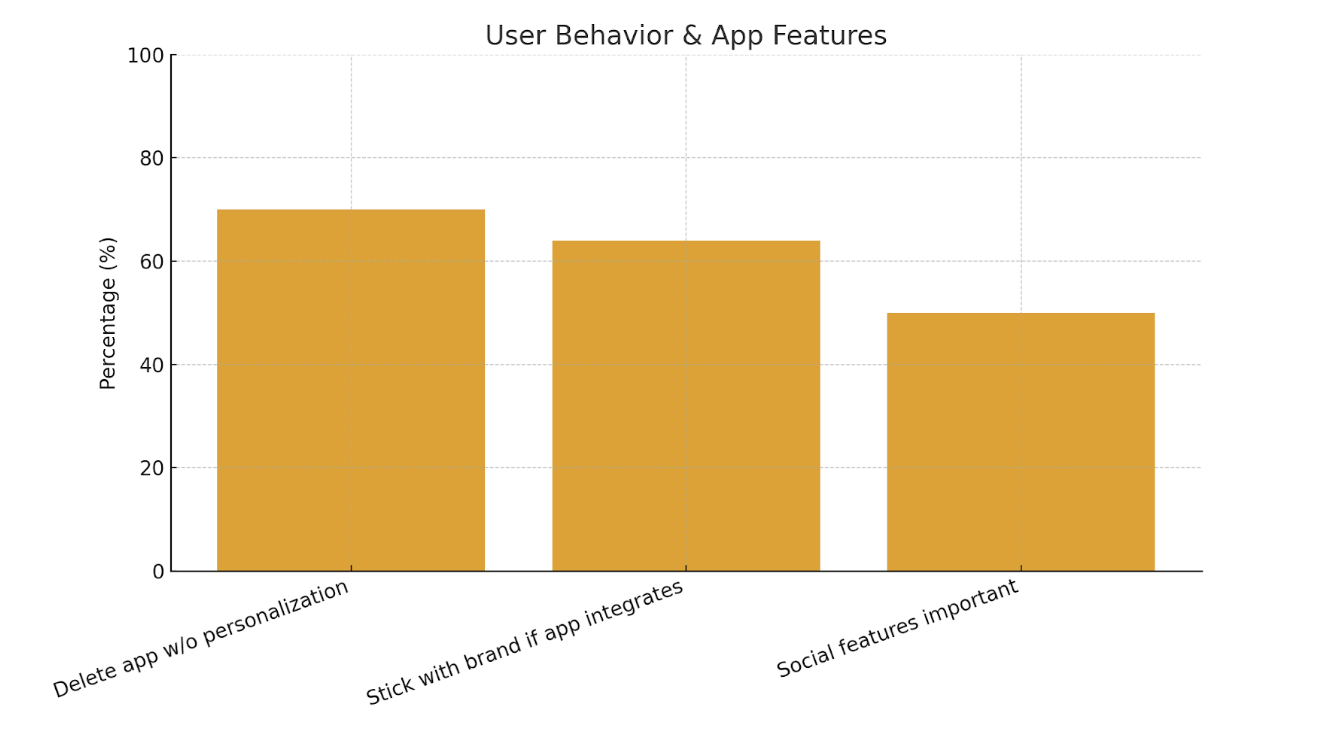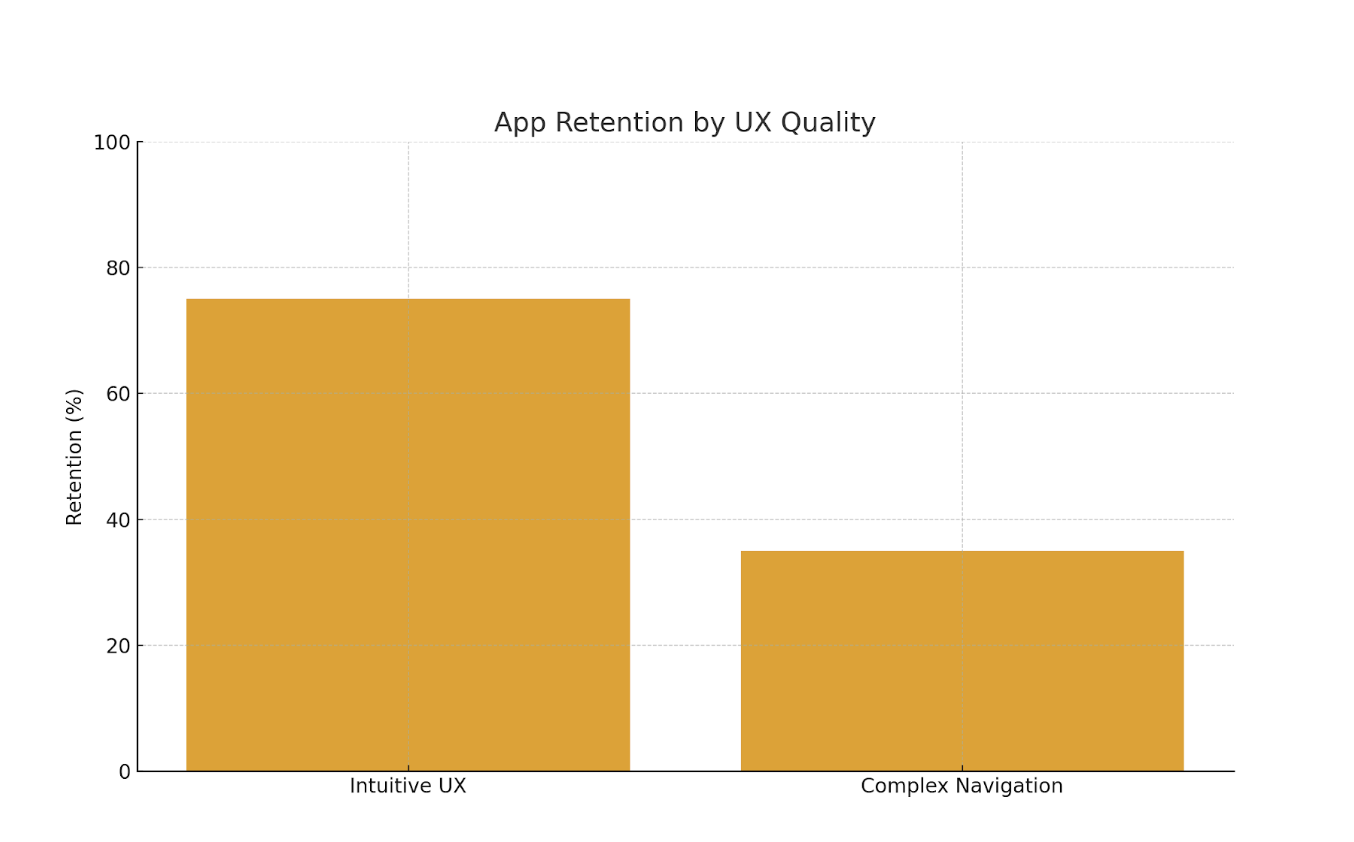In today’s business landscape, it’s no longer enough to simply offer a good product or a competitive price. Customers expect more - attention, convenience, quick responses, and an emotional connection. In 2025, mobile apps have become the main tool through which businesses build long-term relationships with their clients. They have transformed from an additional sales channel into the primary space for interaction between a brand and its users.
Starbucks, Nike, McDonald’s, Sephora, Spotify, and hundreds of other companies have proven that a well-designed mobile app can turn a one-time purchase into a lasting habit, increase the average transaction size, and make a brand part of customers’ daily routines.
In this blog, we’ll take a closer look at:
- How mobile apps drive loyalty in 2025?
- Which features work best?
- Which brands are leading in this area today?
- Which trends will shape development in 2026-2027?
Why Loyalty Is No Longer Built on Price Alone
Just 10-15 years ago, the key competitive advantage for businesses was price. Companies competed with discounts, promotions, and bonuses. But in 2025, this strategy no longer works. Customers have become more demanding: they value not only money, but also time, comfort, and emotional experiences.
Discounts can attract attention but won’t keep customers. If a competitor offers a bigger discount tomorrow, the customer will switch. That’s why brands have had to rethink the meaning of loyalty.
Today, loyalty = personalization + convenience + emotions.
Customers expect that a brand will:
- know their needs,
- offer personalized solutions,
- save their time,
- create a pleasant experience in every interaction.
Examples:
- Amazon: thanks to personalized recommendation algorithms, users rarely leave the platform - they know they’ll find what they need faster here.
- Starbucks: the in-app loyalty program makes buying coffee a habit because every transaction is rewarded with points.
- Nike Run Club: the app motivates users to run more often, which in turn drives more purchases of apparel and sneakers.
<

Personalization is everything: 70% of users delete an app without it, 64% stay loyal if the app integrates with other services, and 50% see social features as key for regular use.
Key Mobile App Features That Build Loyalty
The success of a mobile app is measured not only by downloads but by how actively users stay engaged with the brand after their first interaction. In 2025, several key features have emerged as the most impactful for customer loyalty.
In-App Loyalty Programs
Traditional discount cards have almost disappeared, as all functionality is now integrated into apps. The most effective programs are transparent and instant: users immediately see accumulated points, can redeem them, or claim rewards.
Example: Starbucks - over 60% of all U.S. transactions happen through the app. Customers value not only the rewards but also the convenience: pre-ordering, skipping the line, and receiving personalized offers.
Gamification is an extra driver. For instance, McDonald’s introduced seasonal quests: buying certain items “unlocks levels” and rewards prizes. This turns shopping into a game, creating positive emotions.
Personalized Recommendations
Modern users don’t want to see generic promotions. They want the app to “understand” their habits. AI and big data allow brands to generate unique offers tailored to each customer.
Examples:
- Airbnb increases repeat bookings by 20% through personalized collections.
- Spotify retains millions of users thanks to custom playlists.
This isn’t just a feature - it’s the foundation for building emotional connections.
Push Notifications That Don’t Annoy
The main issue with push notifications is overuse. People quickly delete apps that bombard them with irrelevant alerts. Successful brands use behavioral marketing: notifications are sent only when relevant.
❌ Bad: a generic “10% off everything!”
✅ Good: “You usually order coffee at 9 AM - here’s a discount coupon just for today’s morning order.”
Research from Localytics shows that relevant push notifications increase repeat visits by 23%.
Integrations With Other Services
Mobile apps are becoming the hub of a user’s ecosystem. Integration with Apple Pay, Google Wallet, calendars, delivery services, or even smartwatches makes the experience seamless.
Example: Uber - a user can order a ride directly from Google Maps, pay automatically through a linked wallet, and even share the trip with friends. Fewer steps = more satisfaction.
Social Features
When an app fosters a sense of community, users return more often. These features may include ratings, reviews, and progress sharing.
Example: Strava - it turned fitness into a social network: runners compete, comment on results, and create clubs. This fosters not just engagement but also dependency.

Personalization drives decisions: 70% of users delete an app without a personalized experience, 76% are willing to share more data for relevant offers, and 64% choose a brand with a high-quality app even at a higher price.
UX/UI as a Driver of Loyalty
App design today is not just about aesthetics - it’s about survival. In a world where a user can delete an app after the first launch, high-quality UX/UI becomes a critical factor for retention.
Easy Onboarding
Onboarding is the first introduction to the app. If it’s too complicated, users leave.
Statistics:
- Apps with simple onboarding retain 72% of users after one month.
- If registration is required on the first screen, retention drops to 46%.
Duolingo Case: minimal data is requested at the start, and the user immediately begins a lesson. The “wow” moment happens instantly, motivating users to stay.
Intuitive Navigation
The golden standard: a maximum of three clicks to reach the desired action. If users get lost in tabs and menus, they abandon the app.
Revolut Example: a simple home screen with access to main features. No unnecessary steps; everything is at hand.
Microanimations and Emotional Engagement
Small animations create a sense of lively interaction. They’re not only visually appealing but also encourage users to complete actions.
Nike Training Club uses animations to track progress: every completed workout is accompanied by a celebratory effect. It’s a small detail, but it builds an emotional connection.
Accessibility and Inclusivity
In 2025, design must consider the needs of different user groups: people with visual or hearing impairments, and those who use screen readers. This is not only about social responsibility but also about expanding the audience.
Apple Example: all their apps include built-in VoiceOver features and high-contrast modes.
Speed and Stability
Users do not forgive bugs or long load times. Google research shows that if an app takes more than 3 seconds to load, 53% of people will close it. UX also includes performance and reliability.
User Testing
Top companies constantly check how real people interact with their app. A/B testing, interviews, and click maps help identify weak points.
Amazon Case: thousands of experiments are run weekly in the app to improve conversion and reduce friction.

Conclusion: In 2025, UX/UI is the heart of loyalty. Apps must be simple, fast, emotional, and inclusive. Users stay not with the brand that offers the biggest discounts, but with the one they enjoy interacting with every day.
How to Measure Loyalty in Mobile Apps
Downloads alone no longer mean much. The key metric is activity.
Metrics:
- DAU/MAU - the ratio of daily to monthly users. Optimal value: >30%.
- Retention (90 days) - the share of users who remain active after three months. Target: over 40%.
- NPS - willingness to recommend. Target: 50+.
- CLV - long-term revenue from a single user.
|
Metric |
What it Shows |
Target Value |
|
DAU/MAU |
Engagement |
>30% |
|
Retention 90d |
Retention after 90 days |
>40% |
|
NPS |
Recommendation level |
50+ |
|
CLV |
Long-term revenue |
+10-15% per year |
Big Data + AI = The Future of Loyalty
Modern business can no longer grow without data. Big Data has become the new “currency,” and artificial intelligence (AI) is the key to using it effectively. In mobile apps, these two tools form a true symbiosis: data is collected and structured, while AI analyzes it, generating decisions that directly impact customer loyalty.
How Big Data Shapes the Customer Profile
Mobile apps are capable of collecting thousands of signals about a user:
- how frequently they open the app;
- the times when they are most active;
- which products they view and purchase;
- how they respond to push notifications;
- how they move around the city (through geolocation permission).
Example: The Starbucks app analyzes the times when a customer usually orders coffee and can send a personalized discount in the morning at the moment when the likelihood of purchase is highest. This is a simple yet effective way to enhance loyalty through relevance.
The Role of AI in Personalization
AI turns Big Data into concrete actions. For example, a recent MoldStud case shows that Sephora increased app engagement by ~30% after integrating AI-powered personalized recommendations.
This is not just about recommending products but predicting a user’s needs before they even arise.
Examples:
- E-commerce: algorithms can show a user an accessory exactly when they are most likely planning to buy a new smartphone.
- Fintech: AI can suggest the optimal credit product based on a user’s spending, income, and previous financial behavior.
- Logistics: a courier service app can recommend a more convenient delivery time, considering when the client is usually at home.
- Healthcare: AI can predict when a user might forget to take their medication and remind them in advance.
In each of these scenarios, the user feels that the app “knows them better than they know themselves.” This is the foundation of long-term loyalty.
From Reactive Service to Proactive Service
Traditional service works on the principle: “the user asked - the company responded.” But with Big Data and AI, we move to a new level: proactive service.
Example: Airlines can use AI to predict flight delays and offer alternative routes before the passenger even gets stressed. This not only reduces stress but also builds trust in the brand.
Ethical Considerations and Trust
Data usage always carries risks - users fear excessive control. If a customer feels that an app is “spying” on them, the effect will be opposite. As covered in Medium’s article on ethical personalization, transparency and consumer control are key to maintaining loyalty when deploying AI-driven features.
Therefore, an important loyalty factor in 2025-2027 will be transparency in data handling:
- clear explanation of which data is collected and for what purpose;
- the ability to manage privacy settings;
- guarantees of personal information security.
Brands that communicate openly with customers about Big Data will win in the long term.
Predictions for 2026-2027
Over the next two years, AI will become even more precise thanks to the development of generative models and real-time analytics. This means:
- Recommendations will become even more personalized, not only using purchase history but also context signals and richer real-time inputs (time of day, location, in-app behavior) and, increasingly, multimodal signals (text, voice). These shifts are already visible in retail and services where firms use real-time analytics to serve contextual offers.
- AApps will appear that interact with customers in real time and adapt suggestions on the fly, from recommending shows or products to providing tailored financial advice, powered by low-latency inference and edge deployments. McKinsey and other industry reports highlight how real-time ML inference and generative AI are moving from prototypes to production at scale.
- In logistics, AI will optimize not only delivery but also the customer’s ecological footprint, which will also impact the brand’s image.
How the Role of Apps Will Change in 2026-2027
In 2026-2027, mobile apps will become more than just a tool for interaction between businesses and customers; they will evolve into a true “bridge of trust” and ecosystems covering nearly all aspects of daily life. While in 2025 we already see high levels of personalization and fast service, the next two years will bring several transformative developments.
Strengthening AI and Autonomous Services
AI, which today is used for recommendations or chatbots, will evolve into autonomous solutions in 2026-2027. For example, a mobile banking app will not only alert users to an unwanted transaction but will block it automatically and offer protection options. In e-commerce, apps will analyze user behavior and create “smart carts,” tailoring promotions and offers to individual users.
AR/VR as the New Standard of Interaction
By 2027, augmented and virtual reality will be widely implemented in mobile apps. It will no longer be exotic: trying furniture in your own apartment, “virtual shopping trips” through stores, or even doctor consultations in VR will become commonplace. For customer loyalty, this is a huge advantage: users gain an emotional experience that is difficult to replicate offline.
Expansion of Super Apps
The concept of a “super app,” which has been highly successful in China (WeChat, Alipay), will become increasingly relevant in Europe and the US. By 2027, a mobile app will no longer be a “narrow” service but a platform where a person can pay bills, order a taxi, chat, and even buy insurance-all in one place. This strengthens loyalty: it’s convenient for users to stay in one ecosystem rather than spread themselves across dozens of apps.
Focus on Sustainability and Social Responsibility
By 2027, mobile apps will become an important channel for businesses to communicate eco-messages. Apps will allow users to track their “carbon footprint,” earn rewards for environmentally friendly actions, or participate in social initiatives. This directly impacts loyalty-users increasingly choose brands that align with their values.
Conclusion: 2026-2027 will bring not only technological innovations but also a new model of business-customer relationships. Apps will transform into personal assistants, guides, and even advocates for users’ interests. Loyalty in this reality will be based not on bonuses, but on emotional connection, security, and convenience.
Challenges and Risks for Businesses
Alongside enormous opportunities, mobile apps in the coming years will also present serious challenges. Businesses that focus solely on technological trends may easily lose customer loyalty if they fail to consider the risks.
Cybersecurity and User Trust
Data breaches are increasing every year. In 2026-2027, cyber threats will only intensify, as AI and quantum technologies open new possibilities for hackers. A single high-profile incident involving customer data can destroy years of carefully built loyalty. Therefore, companies will need to invest in multi-layered security, transparent privacy policies, and clear communication with users.
Market Saturation
There are already millions of apps today, and by 2027 competition will become even fiercer. The problem lies in the similarity of services. If an app does not provide unique value, it quickly disappears from smartphone screens. User loyalty in such an environment will only be possible through innovation, personalization, and genuine care.
Regulatory Changes
Europe is already tightening data protection requirements, and in 2026-2027 new laws regulating AI, financial services, and digital assets are expected. For businesses, this means flexibility and readiness to adapt. Failing to respond in time can damage reputation, lead to fines, and erode trust.
Balancing Personalization and Privacy
Customers expect apps to “anticipate” their needs, but they also fear excessive data collection. This is the personalization paradox: too little, and the user sees no value; too much, and they feel their privacy is invaded. In 2027, transparency will be the decisive factor in loyalty: companies that clearly explain what data they collect and why will have an advantage.
Rising Customer Expectations
By 2025, the “instant generation” has already emerged: users want everything “here and now.” By 2027, these expectations will only grow. If an app is slow, has an inconvenient UX, or fails to provide quick responses, it will lose the trust of even loyal customers. Businesses will need to invest in speed, simplicity, and emotional experience.
Conclusion: The challenges of 2026-2027 are no less significant than the opportunities. User loyalty cannot be bought or maintained with technical tricks. It is built on trust, security, responsibility, and genuine dialogue. Only companies that can balance innovation with ethics will come out ahead.
Ready to take your app to the next level? - Book a consultation with KeyToTech and let’s build an app your customers will love - and never want to leave.
Final Thoughts
In 2025, the mobile app became the heart of the interaction between a brand and its customers. It determines whether a customer stays with the company or moves to a competitor.
In 2026-2027, this trend will intensify. Apps will not only respond to user actions but also anticipate their desires. AI, AR/VR, gamification, and super apps will become the new norm.
Businesses that invest in convenient UX, personalization, and transparency will not just retain customers-they will turn them into brand ambassadors.